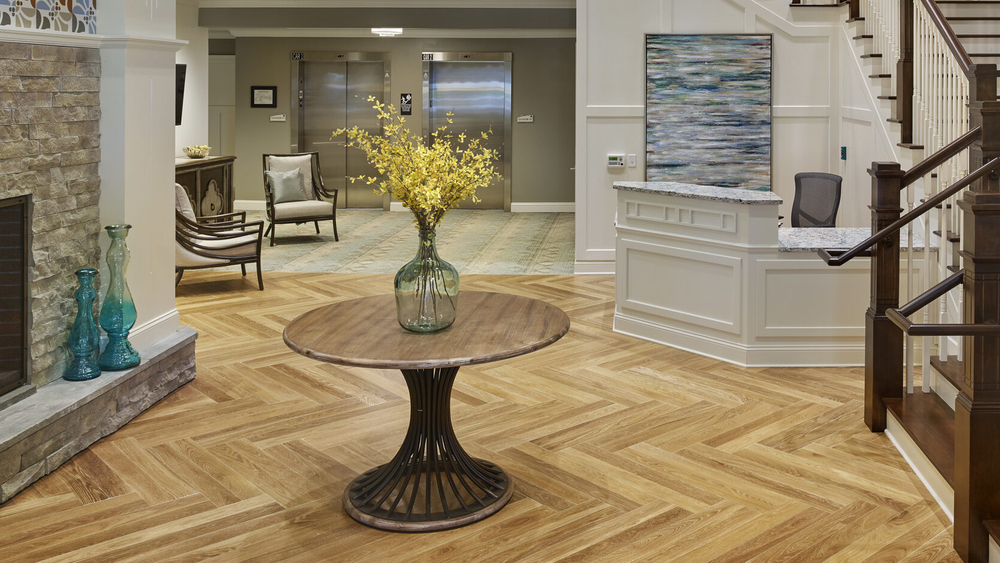There’s nothing quite like the look and feel of real wood flooring. Whether it’s in an office space, a home, or a retail store, wood flooring gives a warmth and charm to the room that’s hard to duplicate with anything else. When it’s time to choose a hardwood for your commercial space, you have a lot of options available to you including the choice between solid and engineered wood. While engineered wood sounds like something made of vinyl only meant to look like wood, it’s actually 100% hardwood just like solid flooring is. The difference is in the way that it’s made – and in the way that it performs.
A Look at the Boards
A solid hardwood plank is just that – 100% solid wood from top to bottom. This is what floors have been made of for hundreds of years in a wide range of species, widths, and styles.
Engineered hardwood floors are made with a solid plywood core topped with a hardwood veneer. The plywood core is important, because it’s made of many different layers – or plies – of wood sandwiched together. These different layers are put together facing different directions from one another, which makes the core of the engineered wood much more stable and resistant to warping or swelling than a solid hardwood plank is.
While no hardwood floor can withstand having a puddle sitting on it for any length of time, an engineered wood floor is much more resistant to moisture. It won’t shrink and swell over time the way that solid wood will, which makes it a better choice for certain applications where solid hardwood can’t be installed.
Flooring Location

Hardwood floors make a great choice for many areas. You can find them on the first or second floor of many homes or businesses – but you rarely see them below grade. Why? Because below grade – or basement level – rooms tend to have much higher moisture levels than those above grade. And solid hardwood can’t withstand that moisture. Over time, it swells, and because it needs to be nailed to the substrate, it can seriously warp as it swells. In addition, an expansion gap must be utilized around the perimeter of the room to help account for this swelling. And while this gap may be covered with a baseboard in traditional buildings, more modern spaces need a cleaner look than a molding can provide.
Engineered wood floors can be installed below grade. So, you can have the same, beautiful, warm, finish on your floors from the top floor of the building right down to the bottom. And because you don’t need to have as large of an expansion gap, you don’t need to utilize a baseboard either, if it doesn’t fit in with your building’s aesthetic.
Refinishing
One of the best parts about having a hardwood floor is the fact that it can be sanded down and refinished if it becomes worn. This is especially important in high-traffic, commercial buildings that see a lot of use over the years. A solid hardwood floor can be sanded down and refinished about 10 times before the thickness of the material becomes an issue.
Engineered wood floors have a veneer on top, which means that they can’t be sanded down as many times as a solid wood floor can. They can be sanded and refinished if you want a different color or look for your floors, but you may find that because of the way that they are made, you don’t actually need to refinish them as often as you would a solid wood floor.
This is because of the way that the boards are produced. Most solid wood floors are sold unfinished. This means that the flooring must be sanded down and a top coat added by the installer after the floors are put in. This is meant to give your floors a better, more even appearance. There are drawbacks to an unfinished floor, however; the finish is only as good as the installer. Unfinished floors tend to require more upkeep and need more refinishing in the future as well.
An engineered hardwood floor will have a factory finish on it, meaning that it does not require additional sanding or finishing after installation. Factory finishes tend to last much longer than those applied by the installer, so while your engineered wood floor may not be able to be refinished 10 times, it also likely won’t require refinishing as many times. In fact, most engineered hardwood floors only require refinishing about twice over their lifetime, and the top veneer is more than substantial enough to withstand this. A factory finish also makes the most sense on any hardwood floor installed in a commercial building where foot traffic tends to be higher.
Flooring Performance
When it comes to performance, any hardwood floor you install in a commercial building is going to have to withstand a lot. Hardwoods in general come in a wide range of different hardnesses, which are rated on what’s known as the Janka scale. The higher the number on the scale, the more durable the floor is and the less likely it will be scratched, dented, or damaged during the normal course of a business day.
In addition to the Janka score, however, you also need to pay attention to the stability of the boards. After all, a hardwood floor is an investment in your property, and not one that you’re likely to want to redo any time soon.
The wood fibers in solid hardwood are all running in the same direction, which means that a solid hardwood plank is more likely to swell, shrink, or warp over time. Depending upon the location of your building, things like changing humidity levels can have a major impact on the state of your floor at any time of year.
Engineered wood planks, with their plywood core, are less likely to swell or warp, and are much less susceptible to moisture levels in the air. They can withstand commercial level foot traffic, and will last for years regardless of location or humidity. Engineered hardwood can even be installed right over concrete in the right conditions, so it’s possible even to convert old factory floors to gleaming new hardwood with beautiful results.
Installation
Solid wood floors can only be installed one way – through nailing or stapling the floor down to the substrate below. A few types of solid wood floor can be installed using adhesive, but because most adhesives contain a high-moisture content, this isn’t always recommended due to the possibility of the wood swelling. Therefore, you need to have a solid, stable substrate for the hardwood to adhere to, which may mean additional work prior to installation.
Engineered hardwood floors can be installed just like solid wood floors, or they can be floated to encapsulate an existing floor. This is ideal for covering things like concrete or old asbestos flooring that can’t be disturbed but must be covered for safety. This makes conversions of old buildings easier, as well as the total installation of the new floor faster than with solid hardwood flooring.
Flooring Costs

A lot of the costs associated with hardwood flooring come both from the installation and the finishing of the wood. Solid hardwood flooring may cost less in some cases, but will cost more to install because it must be sanded and finished, driving up the final cost.
Engineered hardwoods of more common woods such as oak and maple typically cost less than solid planks of the same wood, giving you a more durable, longer lasting finish for less.
Make the Right Choice
Hardwood flooring gives any building a beautiful, timeless appearance. Make sure that you choose a hardwood product that will last as long as your business does with the style and charm you’ve come to expect from hardwood. Consider engineered hardwood flooring for your home to get the best of both worlds.
